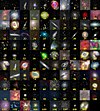Eskimo mist
|
Planetary Nebula Data of the Eskimo Nebula |
|
|---|---|

|
|
| The Eskimo Nebula captured by the Hubble Space Telescope | |
| AladinLite | |
| Constellation | Twins |
|
Position equinox : J2000.0 |
|
| Right ascension | 07h 29m 10.7s |
| declination | + 20 ° 54 ′ 43 ″ |
| Appearance | |
| Apparent brightness (visual) | 9.1 mag |
| Apparent brightness (B-band) | 9.9 likes |
| Angular expansion | 0.9 |
| Central star | |
| designation | HD 59088 |
| Physical data | |
| Redshift | +0.000281 |
| Radial velocity | +84.2 km / s |
| distance | 3000 ly |
| history | |
| discovery | Wilhelm Herschel |
| Date of discovery | January 17, 1787 |
| Catalog names | |
| NGC 2392 • PK 197 + 17.1 • GC 1532 • H IV 45 • h 450 • | |
The Eskimo Nebula , NGC 2392 , is a planetary nebula in the constellation Gemini . It has a size of 0.8 '× 0.7' and an apparent magnitude of 9.1 mag, making it easy to observe with smaller telescopes. The nebula is around 3,000 light years from the solar system with an extension of 0.7 light years.
The nebula was formed about 10,000 years ago when the sun-sized central star shed its outer shell in an eruption.
Studies have shown that the central star is surrounded by two concentric gas envelopes that expand at different speeds. The shells are stimulated to glow by the strong radiation from the very hot central star.
The central star is an O8 dwarf star with about 40 times the luminosity of the sun. The absolute brightness is given as about +0.7 mag and the surface temperature is about 40,000 Kelvin.
In reality, NGC 2392 is probably not as round as it looks, but rather bipolar in shape, whereby we look into its polar axis.
Appearance
A telescope is necessary to observe the Eskimo Nebula . It can be seen in good binoculars , but only as a weak point of light. Even in a small telescope with an opening of around 10 cm, the Eskimo Nebula can be seen as a small disk. It can be helpful to use a mist filter . With larger openings, interesting features can then be seen, such as the division into two bowls and the arch, which looks like the hood of an Eskimo. With telescope openings larger than 50 cm, which are unusual among most amateurs, you can try your hand at a challenge: On the opposite side there is a dark place in a fragment of gas called a bridge . In addition to a large telescope, perfect conditions for seeing are necessary for successful sighting , as they can only be found in the high mountains in Central Europe.
